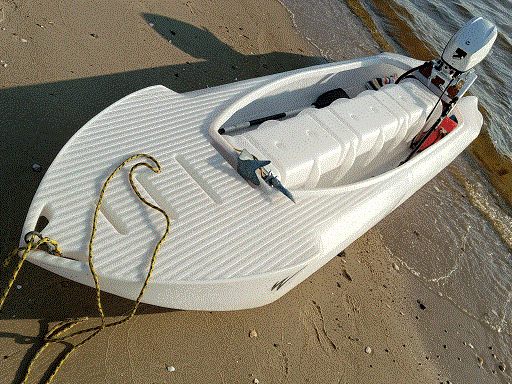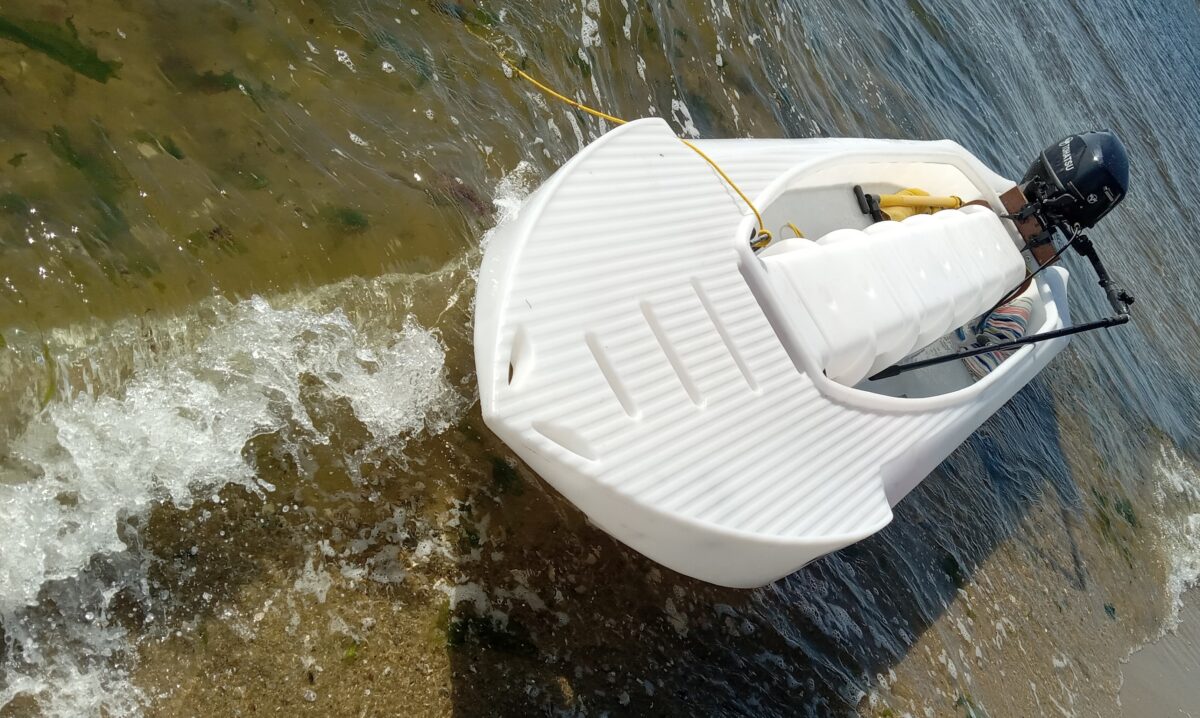Against our own recommendation… 🙂
Warning!
The S4 Microskiff is designed and rated for an outboard motor up to 6 HP. Overpowering it may be illegal in some states that forbid driving overpowered boats.
A 6 HP outboard motor fits the S4 perfectly, works perfectly with it, and driving the S4 with it is easy. However, powering this boat with a 9.8 HP motor must be done only after its transom has been reinforced, and both boat and motor outfitted in a way that effectively prevents spray shooting upward from the bigger propeller shaft from entering the cockpit.
Failing to perform either of these critical safety modifications is hazardous, and it could result in accidents and damage to the boat.
Inexperienced drivers should exercise caution when attempting to drive an overpowered S4, and take the time to learn how to drive it safely.
Does Wavewalk recommend trying to outfit an S4 with such a powerful motor?
No, we don’t, and for several reasons, the primary and most important of which are legal (see above warning) and safety related: The S4 Microskiff’s official power rating is 6 HP, and we’re not going to change it because if we did we’d have to offer a new version of this boat that fits such a motor, and we think the market for such a “muscle” microskiff doesn’t justify such a move.
Other problems with overpowering an S4 Microskiff?
Yes, and the first is that although the 9.8 HP Tohatsu outboard is the most lightweight in its class (together with the Mercury 9.8 HP), at 85 lbs it still weighs 25 lbs more than the 6 HP outboard from the same brand. This may not be a problem for some S4 owners, but it could be one for others. In other words, while carrying a portable 6 HP motor is possible and even easy for most owners, an 85 lbs is considerably less portable, and for many people it might be barely movable.
Other problems with such a project are related to the difficulty of reinforcing the transom, and of protecting the back of the cockpit from spray shooting up from the propeller shaft and splashing in. The former is pretty straightforward, but the latter is complicated and potentially frustrating, and only a skilled person with a good technical sense as well as patience may succeed in it. When we did it we relied on Captain Larry Jarboe’s multiyear experience in these matters, and the solid advice that he provided, but it still took us weeks before we achieved the required “zero spray in” point.
Note that the propeller shaft thickness is also a factor to consider, as a thicker shaft generates more resistance from the water, and therefore shoots more spray upwards, and some of this spray can find its way get into the rear part of the cockpit if this problem is not taken care of effectively.
And what are the advantages?…
More power means higher speed. But although a 9.8 HP motor generates 63% more power than a 6 HP motor, and it features a propeller with both a bigger diameter and a bigger pitch, it doesn’t drive the boat faster at the same rate, because of hydrodynamics. Well, not even close.
The degree to which such a bigger motor would improve the boat’s speed depends on multiple factors, and it is hard to assess accurately. Our educated impression is that the S4 is about 25% faster running a 9.8 HP motor compared to a 6 HP motor, and this is a noticeable difference.
In absolute terms a savvy 150 lbs driver is likely to go with their S4 at 20 mph on mirror flat water. Anyone who weighs more should expect to go slower than this.
This may surprise some people, but consider these figures:
The S4 weighs 100 lbs, and the motor plus fuel tank weigh 100 lbs at the minimum, a total of 200 lbs.
A US adult male weighs 200 lbs on average, which is equivalent to the combined weight of this boat plus a 9.8 HP motor, and the combined weight of driver + boat + motor is roughly 400 lbs. This is the weight that a 9.8 HP motor is required to push forward while gravity pushes this weight downward…
And by the way, a lightweight 6 HP motor is required to push forward 25 lbs less.
In comparison, a 150 lbs driver would reduce the total combined weight of boat + motor + driver by 12.5%, from 400 lbs to 350 lbs, a difference that thanks to hydrodynamics would produce a speed increase that’s bigger than 12.5%.
A different way to look at these numbers would be the following:
An S4 microsiff driven by 150 lbs driver and propelled by a 9.8 HP outboard weighs about 350 lbs in total. Change the driver to one who weighs 200 lbs, and the total weight of this compound object would increase to 400 lbs, which is ≈14.3% heavier. However, in such case hydrodynamics would work against the driver disproportionately, and the decrease is speed would be bigger than the 14.3% increase in total weight.
A driver weighing 180 lbs should be content with reaching 18 mph in optimal water conditions.
This said, if you like speed, driving a faster and more powerful boat is more fun.
Typically, 9.9 HP motors are somehow heavier than 9.8 HP motors, and some models are much heavier. The most lightweight 9.8 HP outboard motors are offered by Tohatsu and Mercury (85 lbs).
Cost
9.8 HP outboard motors cost about half more than 6 HP motors.



Owner’s review of his S4 Microskiff powered by a 9.9 HP Mercury outboard motor >>